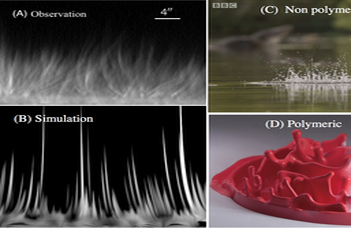From alligator mating calls to heavenly dance of the Sun
Jet-like behaviour is extremely common in nature. One of the most visually appealing examples occurs during the mating display of the male alligator, when the alligator submerges its neck just below the water-line and bellows at bass frequencies, causing jets of water to dance in a beautiful display on the lake surface. The physical mechanism responsible for this effect is known as Faraday excitation and was first demonstrated in a shallow fluid with an elastic membrane by English physicist, Michael Faraday in 1831. Far away on the Sun’s surface, a similar display of jet-like behaviour is ubiquitously observed in the super-hot plasma, also called the fourth state of matter, in the form of ‘spicules’. However, unlike with the jets caused by the amorous male alligator, solar spicules are yet to be fully explained.
To make progress towards fully understanding solar spicules, a team of researchers from Hungary, India and UK, including Prof Robertus Erdélyi and Dr Marianna B Korsós (Dept. of Astronomy, Eötvös University and also at Hungarian Solar Physics Foundation, Gyula, Hungary, http://hspf.eu) have found an intriguing connection between fluid solutions vibrating on a speaker displaced horizontally and the forest of vertically elongated plasma jets known as spicules on the Sun’s surface. Father Secchi originally discovered spicules in 1872. However, they remain one of those miscellaneous objects in modern plasma-astrophysics.
The group, led by Dr. Piyali Chatterjee, from the Indian Institute of Astrophysics, Bengaluru, proposed a very simple mechanism to understand the formation, as well as abundance, of spicules. Essentially, the ubiquitous and well understood convection in the lower solar atmosphere - analogous to boiling water in a hot pan - serves almost periodic but strong kicks to the plasma in the solar chromosphere, the shallow layer just above the visible solar surface. The material in the chromosphere is 500 times lighter than the photosphere, meaning these strong kicks from the bottom shoot the chromospheric specular plasma outward in the form of elongated jets, between 300-1000 km wide and 5000-30000 km tall. In the observed solar atmosphere, spicules come in all sorts of different heights and speeds, with this complexity being one of the main obstacles to understanding their formation. Now, the work of this international team has shown for the first time that solar convection can, by itself, drive all kinds of different jets.
Prof Erdelyi said: “We have worked as a team, and enjoyed learning a lot from our early career scientists, Mr Sahel Dey a PhD student, and post-doctoral researchers Dr Marianna B. Korsós, Jiajia Liu, and Chris Nelson who all made very important contributions. The Indian team, lead by Dr Piyali Chatterjee and including Dr Murthy, with their unique insight into polymer fluid physics has made a truly fundamental discovery.”
“The common mechanism known as non-linear wave breaking is also manifested in other areas like rogue waves in oceanography, spiral arms of galaxies, fibre optics, etc.”
Dr Marianna Brigitta Korsós, also a Post-Doctoral Research Assistant in the Solar System Physics Group at the Department of Physics at Aberystwyth University said: “This research was about finding direct evidence for how about 3 million spicules are present on the Sun at any given time. I am very proud to be part of this collaboration as a young female researcher at Aberystwyth University and I have learnt that how two different research fields jointly can find simple explanation for a long-standing science problem. Now, I strongly believe that different research fields should do joint projects because they can learn from each others and make leap forwards in the science. ”
This work is extremely important in the field. Due to the high frequency of spicules - about 3 million are present at any one time in the solar atmosphere - it is thought that these events could play a key role in carrying the mass and energy required to account for key open problems in solar physics, including sustaining the solar wind and heating the solar corona to millions of degrees K.
The researchers have published their findings in the journal Nature Physics. The team from Hungary contributed with expertise on data analysis from observations taken by the IRIS spacecraft and used advanced processing techniques when analysing the data.
The paper Polymeric jets throw light on the origin and nature of the forest of solar spicules was published in Nature Physics on Thursday 3 March 2022.

